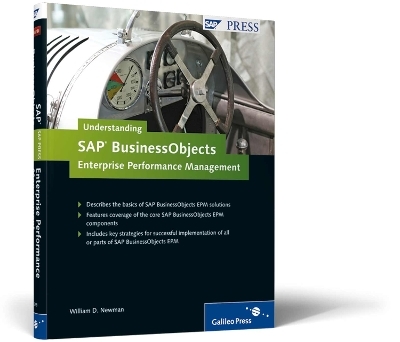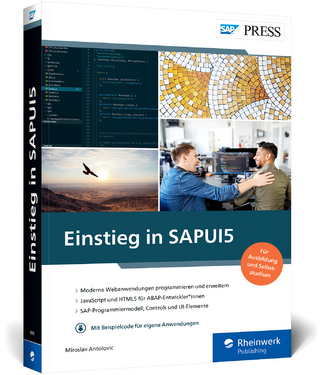
Understanding SAP BusinessObjects Enterprise Performance Management
SAP Press (Verlag)
978-1-59229-348-3 (ISBN)
- Titel ist leider vergriffen;
keine Neuauflage - Artikel merken
Visibility Across the Enterprise Discover how the various components of SAP BusinessObjects EPM can be integrated with other ERP and source data applications to provide visibility and transparency across the organization. Innovation Understand what SAP EPM technologies are available to support true innovation in your business. Scenario-Based Approach Get real-world insight on the strategies, best practices, and recommended approaches for implementation of the core components.
William Newman is the managing principal of Newport Consulting Group, a strategy firm aligned with SAP focused on EPM and GRC solutions. He has 25 years of experience in the development and management of strategy, process, and technology solutions for world-class manufacturing and service organizations such as Boeing, General Motors, Volkswagen, Northrop Grumman, Honeywell, and Intel. He holds a BS degree in aerospace engineering from the Henry Samueli School of Engineering and Applied Science at UCLA, and an MBA in management and international business from the Conrad L. Hilton School of Management at Loyola Marymount University. He is a member of the adjunct faculty at the University of Michigan-Dearborn, College of Business.
* ... Foreword ... 13 * ... Preface ... 15 * ... Acknowledgments ... 17 * 1 ... Introduction to Enterprise Performance Management ... 19 * 1.1 ... Introduction ... 20 * 1.1.1 ... Approaches to Enterprise Performance Management (EPM) ... 21 * 1.1.2 ... The Strategy Gap ... 23 * 1.2 ... The Fundamentals of Strategy ... 24 * 1.2.1 ... The Strategy Pyramid ... 24 * 1.2.2 ... Roadblocks to Strategy Execution ... 26 * 1.3 ... SAP BusinessObjects Solution Offerings ... 27 * 1.4 ... Current Issues in Strategy Formulation ... 30 * 1.5 ... Current Issues in Business Planning and Forecasting ... 33 * 1.5.1 ... The Reporting Process ... 34 * 1.5.2 ... Governance Reporting and IFRS ... 37 * 1.6 ... Current Issues in Financial Information Management ... 37 * 1.7 ... Current Issues in Supply Chain Effectiveness ... 38 * 1.8 ... Introduction to the SAP BusinessObjects Enterprise Performance Management (EPM) Solution ... 40 * 1.9 ... Structuring an EPM Initiative in an Organization ... 45 * 1.10 ... Summary ... 47 * 2 ... Enabling Corporate Strategy Formulation and Execution ... 49 * 2.1 ... How and Why Companies Formulate Strategies ... 51 * 2.1.1 ... Development of Strategy and Strategic Planning ... 53 * 2.1.2 ... Strategy Formulation for Corporate versus Functional Strategy ... 55 * 2.1.3 ... Strategy Formulation during Compelling Events ... 55 * 2.1.4 ... Strategy Formulation for Corporate Sustainability Programs ... 56 * 2.2 ... Methods Used to Articulate Strategy ... 59 * 2.2.1 ... Balanced Scorecards ... 60 * 2.2.2 ... Strategy Maps ... 63 * 2.2.3 ... Logical Models ... 65 * 2.2.4 ... Portfolio Diagrams ... 66 * 2.3 ... Deploying Corporate Strategy Across the Organization ... 68 * 2.4 ... Leveraging SAP BusinessObjects Strategy Management ... 70 * 2.5 ... Leveraging SAP BusinessObjects Sustainability Performance Management ... 78 * 2.6 ... Common Strategy Management Tools and Templates ... 82 * 2.6.1 ... SAP BusinessObjects Strategy Management Architecture and the PAS Data Cache ... 82 * 2.6.2 ... Alignment with SAP BusinessObjects Risk Management ... 84 * 2.6.3 ... Alignment with SAP BusinessObjects Planning and Consolidation ... 84 * 2.6.4 ... Alignment with SAP BusinessObjects Profitability and Cost Management ... 86 * 2.6.5 ... Alignment with SAP BusinessObjects Sustainability Performance Management ... 86 * 2.6.6 ... Considerations for SAP ERP Applications ... 87 * 2.7 ... Describing and Monitoring Key Performance Indicators ... 89 * 2.8 ... Summary ... 92 * 3 ... Business Planning and Forecasting ... 95 * 3.1 ... How and Why Companies Approach Planning ... 97 * 3.1.1 ... The Differences Between Strategic Planning and Alignment ... 97 * 3.1.2 ... Business Planning as an Outcome of Strategy Formulation ... 99 * 3.1.3 ... Business Planning as an Outcome of Forecasting ... 104 * 3.2 ... Methods Used to Articulate Business Planning and Forecasting ... 104 * 3.2.1 ... Cost Allocation ... 104 * 3.2.2 ... Activity-Based Costing ... 106 * 3.2.3 ... Cost and Profitability Reporting ... 108 * 3.3 ... Using SAP BusinessObjects Planning and Consolidation for Budgeting and Reporting ... 110 * 3.4 ... Using SAP BusinessObjects Profitability and Cost Management for Planning and Forecasting ... 115 * 3.5 ... Building a CAPEX Planning Environment Using SAP BusinessObjects BPC ... 122 * 3.6 ... Emerging Solutions in Liquidity Planning ... 131 * 3.7 ... Common Business Planning Tools and Templates ... 134 * 3.7.1 ... Choosing Between SAP BusinessObjects BPC Versions: SAP NetWeaver or Microsoft ... 134 * 3.7.2 ... Migrating From SAP BusinessObjects BPC for SAP NetWeaver 7.0 to 7.5 ... 137 * 3.7.3 ... Understanding and Configuring the Starter Kit for IFRS ... 138 * 3.7.4 ... Alignment with SAP BusinessObjects Strategy Management ... 142 * 3.7.5 ... Alignment with SAP BusinessObjects Financial Consolidation ... 142 * 3.7.6 ... Considerations for ERP Environments ... 142 * 3.8 ... Summary ... 145 * 4 ... Creating and Analyzing Financial Scenarios ... 147 * 4.1 ... From Planning to Execution to Consolidation ... 148 * 4.1.1 ... Scenarios Driving Financial Performance ... 150 * 4.1.2 ... Scenarios Driving Financial Close ... 155 * 4.1.3 ... Scenarios Driving Financial Compliance ... 159 * 4.2 ... Using SAP BusinessObjects Financial Consolidation to Enable the Fast Close ... 164 * 4.3 ... Aggregating Financial Information Using SAP BusinessObjects Financial Information Management ... 171 * 4.4 ... Common Financial Management Templates and Tools ... 174 * 4.4.1 ... Understanding and Configuring the Starter Kit for IFRS ... 175 * 4.4.2 ... Alignment with SAP BusinessObjects Strategy Management ... 177 * 4.4.3 ... Alignment with SAP BusinessObjects Planning and Consolidation ... 178 * 4.4.4 ... Considerations for SAP ERP Applications ... 179 * 4.5 ... Special Considerations for XBRL Publishing ... 181 * 4.6 ... Special Considerations for Intercompany Processing ... 184 * 4.7 ... Summary ... 187 * 5 ... Enabling Supply Chain Effectiveness ... 189 * 5.1 ... Management Elements of Supply Chain Effectiveness ... 191 * 5.1.1 ... Supplier Effectiveness Using Quality Management ... 192 * 5.1.2 ... Supplier Effectiveness Using Lean Business Systems Planning ... 195 * 5.1.3 ... Supply Chain Effectiveness During Compelling Events ... 197 * 5.1.4 ... Supply Chain Effectiveness for Corporate Sustainability Programs ... 200 * 5.2 ... Methods Used to Create Supply Chain Effectiveness ... 201 * 5.2.1 ... Managing Supplier Spend ... 201 * 5.2.2 ... Optimizing the Supply Chain ... 204 * 5.2.3 ... Leveraging Flex Points in Budget and Planning Cycles ... 206 * 5.3 ... Demand versus Supply Management ... 207 * 5.3.1 ... The Outsourcing Paradox ... 207 * 5.3.2 ... Consideration for Intellectual Property Source Flow ... 209 * 5.3.3 ... Consideration for Material Make Flow ... 209 * 5.3.4 ... Consideration for Product Delivery Flow ... 211 * 5.4 ... Assessing Supply Chain Costs in the Organization ... 212 * 5.4.1 ... Consideration for Direct External Costs ... 213 * 5.4.2 ... Consideration for Indirect External Costs ... 213 * 5.5 ... Using SAP Spend Performance Management for Corporate Purchasing Effectiveness ... 214 * 5.6 ... Using SAP BusinessObjects Supply Chain Performance Management to Optimize the Value Chain ... 221 * 5.7 ... Common Supply Chain Effectiveness Tools and Templates ... 228 * 5.7.1 ... Leveraging the Business Compendium ... 229 * 5.7.2 ... Alignment with SAP BusinessObjects Strategy Management ... 229 * 5.7.3 ... Alignment with SAP BusinessObjects Risk Management ... 229 * 5.7.4 ... Alignment with SAP BusinessObjects Business Planning and Performance ... 230 * 5.7.5 ... Alignment with SAP BusinessObjects Profitability and Cost Management ... 230 * 5.7.6 ... Alignment with SAP BusinessObjects Global Trade Services ... 230 * 5.7.7 ... Considerations for SAP ERP Applications ... 231 * 5.8 ... Reporting, Auditing, and Monitoring ... 233 * 5.9 ... Summary ... 234 * 6 ... Conclusion ... 237 * 6.1 ... Strengths and Limitations of SAP BusinessObjects EPM Approaches and Solutions ... 237 * 6.1.1 ... Strategic Alignment ... 238 * 6.1.2 ... Increased Transparency ... 239 * 6.1.3 ... Software as a Substitute for Sound Management Practices ... 240 * 6.2 ... Considerations for Dashboards, Reporting, and Analytics ... 240 * 6.2.1 ... The Effective Use of Dashboards ... 241 * 6.2.2 ... Use of Industry Templates and Reporting ... 244 * 6.2.3 ... Leveraging BI Analytics ... 246 * 6.3 ... Considerations for Organization Change Management ... 247 * 6.3.1 ... Initiative Mapping and EPM Programs ... 247 * 6.3.2 ... Resourcing and Funding for EPM Programs ... 249 * 6.3.3 ... Communications Planning for EPM Programs ... 250 * 6.3.4 ... Risk Management of EPM Programs ... 251 * 6.4 ... Emerging SAP BusinessObjects EPM Best Practices and Future Roadmap ... 254 * 6.4.1 ... SAP BusinessObjects EPM Program Planning ... 254 * 6.4.2 ... SAP BusinessObjects EPM Program Deployment ... 256 * 6.4.3 ... SAP BusinessObjects EPM Future Roadmap ... 259 * 6.5 ... Summary ... 259 * ... Glossary ... 261 * ... The Author ... 267 * ... Index ... 269
| Erscheint lt. Verlag | 30.7.2010 |
|---|---|
| Reihe/Serie | SAP Press |
| Verlagsort | Maryland |
| Sprache | englisch |
| Maße | 175 x 229 mm |
| Einbandart | gebunden |
| Themenwelt | Mathematik / Informatik ► Informatik ► Netzwerke |
| Informatik ► Weitere Themen ► SAP | |
| ISBN-10 | 1-59229-348-4 / 1592293484 |
| ISBN-13 | 978-1-59229-348-3 / 9781592293483 |
| Zustand | Neuware |
| Informationen gemäß Produktsicherheitsverordnung (GPSR) | |
| Haben Sie eine Frage zum Produkt? |
aus dem Bereich


